|
|
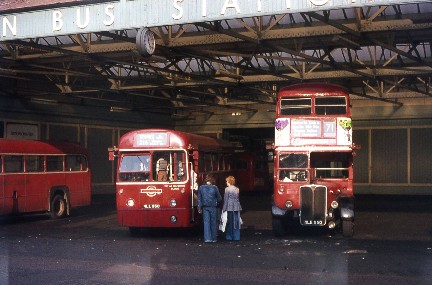 Red RF routes Red RF routes
Route 216
Page last updated 27 December
2018
Kingston's north of the river route to Staines, essentially
unchanged for the last 75 years and recipient of Kingston Garage's
first RFs.
Five to five on
Saturday 18 Sep 76, a week before the 216's conversion to
Bristols. By the end of the year, the remaining Kingston RFs
will only be running on the 218 and 219. RF532 loads for
Staines via Sunbury, RT4286 on the 71
still shows Kingston as its destination.
Photo © John Parkin
Dates of RF operation
1 Jul 59 to 25 Sep 76 (and unscheduled to 30 Mar
79)
Converted to OMO 18 Nov 64
(total 17 years 3 months, of which 5
years 5 months crew-operated)
Destinations
KINGSTON Bus Station and STAINES Moor Lane via
Sunbury
RF Garages
K Kingston
NB Norbiton (Sunday allocation until 13
Oct 59)
Reason for single-deck operation
The LT route was initially one-man operated with small
single-deckers, presumably for economy due to low passenger
numbers. However, the route became busier and was converted
to full-size buses during the war. Whilst there is no
height restriction meaning the route could not have been
double-decked, in accordance with LT policy, Thames Street in Lower
Sunbury is very narrow with projecting buildings and signs.
Given the objections of local residents (who wanted the street
closed altogether), it seems likely that there was a combination of
factors (thanks to Ian Hogben
for additional information).
The old terminus at Kingston Station
forecourt. The 216 shared the stand with Leatherhead's 406
and 418 routes. Here in 1950, new RT3169 on the 418
waits next to T738, half way through its nine year life
with LT. All three routes still operate from Kingston, with
the 406 and 418 now the only two interworked routes on
the network.
Photo © J Aston
Route history
The story starts with Sunshine Saloon Coaches, an independent
operator in Kingston who had commenced operation of a weekday
service between Kingston and Ashford Station, sometime in the
late 1920s. The service is described as 'supported by the
department store Bentalls', which seems to have amounted to
coffee/tea at a reduced price in the Bentalls café on presentation
of a Sunshine Saloons ticket. The one-vehicle service was
operated by coaches, but was licensed by the Traffic Commissioners
in 1931 as a bus service. For a year before the business was
acquired by Green Line in December 1933, the route faced
competition from the new General route 198, and there would
have been little to pass to Central Buses. The only impact
seems to be that Green Line reduced the minimum fare
from Sunbury from 1/- to 6d after Sunshine was acquired.
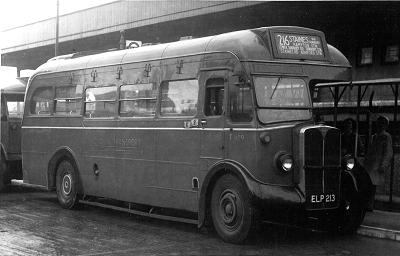
Kingston was the last home
of the ex-Green Line 10T10s, once the pride of the fleet.
They doubtless provided a wonderful ride on the 216. About a
year before the last was withdrawn from regular service, T489 sits
at the 216 terminus in kingston Station lay-by.
Photo ©
Alan Cross
Meanwhile, the General had introduced route 198 between Kingston
and Staines via Sunbury on New Year's Day 1933, competing directly
with Sunshine Saloon. The original intention had been to run
to Chertsey and cover the western end of the 90 (over Chertsey
Bridge, thus allowing the last double-deck Ks to be retired),
but approval was not forthcoming and that section was covered by
new route 137 in the summer of
1932.
The new 198 provided a service to many roads in fast-expanding
west London that were new to the General. It used four
one-man operated 18-seat DA-class Dennis Darts (allowing a bus
every 30 minutes, almost three times the frequency of the Sunshine
Saloon service), and ran seven days a week. The General
became the LPTB in July and the route was renumbered 216 in October 1934.
Traffic built up on Saturdays and summer Sundays, with an
increase to 10 buses required by 1936. The little Darts were
however retained until the 1939, when they were replaced by brand
new CR-class rear-engined Cubs, the first of which were delivered
to Kingston for the 206 and 216 just
after the outbreak of war. Despite their half-cab design,
these operated as one-man buses and enough had been delivered by
November 1939 for the petrol DAs to go into store.
The CRs with their untested design were not suited to wartime
use and were put into store within a couple of years. January
1941 saw the Kingston to Sunbury short-workings converted to crew T
operation and the route was converted fully to crew operation,
using LT Scooters, on 30 Sep 42.
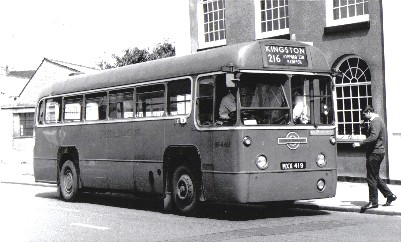 A summer 1968 view of RF442 loading passengers,
presumably at the start of the route in Staines. A summer 1968 view of RF442 loading passengers,
presumably at the start of the route in Staines.
Photo © Alan Cross, Peter
Gomm collection
The allocation of Scooters continued, supplemented by Ts at the
weekends from 1946, until replaced by new TDs in 1949. Still
the Saturday and summer Sunday workings required extra buses, so
the dozen allocated TDs continued to be supplemented by Ts.
In January 1947, the layby at Kingston Station was opened to take
the pressure off the Bus Station, and henceforth the 216 terminated
here.
The number of Sunbury to Kingston short-workings was halved in
June 1951, when the 264 was extended from
Sunbury to Kingston. At the same time, their terminus moved
from Sunbury Village to Sunbury Station. Extra journeys on
Wednesdays from 1951 to 1955 were covered by TDs borrowed from the
215. The additional 6 TDs provided
on Saturdays for the Kingston to Sunbury short-workings were
replaced from May 1959 by an extension of double-deck route
71 to Sunbury, using 5 RTs. From
1952 to 1959, the extra Sunday buses were operated by Norbiton,
first allocated Ts, then TDs, and finally RFs.
The 216 was one of the Central Area routes selected for the
re-introduction of one-man operation planned for 1959, as part
of the efficiency savings resulting from the 1958 bus strike.
Drawn from the pool of RFs available from their replacement by
double-deckers on the 233 at West Green,
plus a few of those released by the conversion of the 208A into RLH route 178, red RFs 502
to 538 were converted in the spring of 1959. However, union
agreement was not forthcoming and so the buses were used as crew
buses to replace TDs at Uxbridge and Romford and on the 216 at
Kingston. 11 of the batch were licensed on 1 July (RFs 506,
511, 518, 523, 525, 526, 527, 529, 530, 531, 533, of which the
first and last had preceded the others as trainers), Kingston's
first RFs. These buses also replaced TDs on the Sunday
operation of the 206, recently switched
to Kingston, from the following Sunday. No doubt the
additional seating capacity of the RFs was a factor in the choice
of the 216.
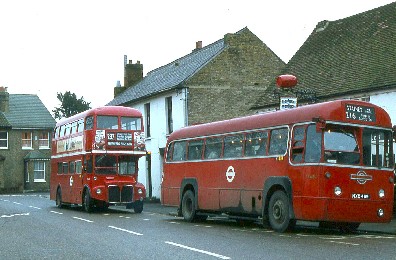 Crew RFs operated the route for
nearly 5½ years before OMO finally did return to the Central
Area. The 216 was one of four routes converted on 18 Nov 64,
along with the 201, 206 (by now operated
from Fulwell) and the 250. In
another 6½ years there would be no more single-deck crew
operation in London. Crew RFs operated the route for
nearly 5½ years before OMO finally did return to the Central
Area. The 216 was one of four routes converted on 18 Nov 64,
along with the 201, 206 (by now operated
from Fulwell) and the 250. In
another 6½ years there would be no more single-deck crew
operation in London.
RF492
sits at the Three Fishes in Sunbury Village, terminus of the
237, on 30 Mar 79, the last day of RF operation at Kingston and
well after the 216 had converted to BL operation. RM863
behind illustrates the change that came over route 237 after its long run of RF operation.
Photo © John
Parkin
Otherwise the stability of the route continued, with RF
operation giving way to new BL-class Bristols on 26 Sep 76 - but
with RFs appearing periodically up until their last day in service
(on routes 218 and 219), 30 Mar 79.
September 1982 saw the route move to Norbiton and convert to LS
operation, with an extension to Tolworth coming at the start of
1983. The section between Kingston and Tolworth gained a
schoolday double-deck operation (using Metrobuses) from 1984 to
1987, when that section became new route K2. Otherwise,
the 216 has been single-deck operated since its inception.
The route enjoyed a summer Sunday extension to Thorpe Park
between 1985 and 2002 (except 1986/7 and 1992-4, when the whole
Sunday operation was replaced by LCBS routes). Meanwhile,
from 1987, the service had been operated commerically by Westlink
from Kingston garage; Westlink was acquired by London United in
1995.
The Nationals lasted until February 2000. The next type to
appear were the Dennis Dart DWL class, a type already familiar on
the route, since they had been operating it on Sundays since 1995.
However, these Wright-bodied Darts only lasted until 2002, when
they were replaced in turn by DRLs, which were Darts bodied by
Reeve-Burgess. Two months later, at the end of June 2002, London
United lost the contract to Tellings Golden Miller, a company based
in Feltham, who used their blue, white and yellow liveried Optare
Excels on the route. Exactly one year later, in 2003, London United
won the contract back using DPS-class Darts from Hounslow Heath
garage.
In 2006, the route was transferred to Fulwell garage to make
room at Hounslow Heath for route 116. The twelve year stint of DPS
operation finally came to an end in August 2015, when Dennis Dart
Enviro 200s, DEs, took over, and the route returned to Hounslow
Heath.
More 216 pictures here.
Thanks to Russell Fell for notes on recent history.
Based on 1964 bus map © London
Transport
RF route in detail, with timing points
KINGSTON Bus Station, Wood Street, Clarence Street,
Kingston Bridge, Hampton Court Road, Hampton Court Vrow Walk, Hampton
Court Road, Thames Street, Station Road Hampton, Hampton Station, Percy Road, Upper Sunbury
Road, Staines Road East, Harfield Road, Lower Hampton Road, Thames
Street, Sunbury Village Flower
Pot (later returns via Church Street Sunbury), Green
Street, Sunbury Clock
Tower, Staines Road West, Ashford Common Black Dog,
Chertsey Road, Feltham Hill Road, Feltham Hill Road Elgin Ave,
Feltham Hill Road, Convent Road, Church Road Ashford, Ashford Station, Stanwell Road,
Stanwell Bulldog,
London Road, High Street Staines, Clarence Street, Bridge Street,
STAINES Moor Lane.
In Staines, buses stood at Staines West GWR station
(closed). During the period of RF operation, new or revised
one-way systems were introduced in Staines and Kingston.
Frequency
| Year |
Mon-Fri |
Sat |
Sun |
| 1936 |
30 mins |
20 mins * |
30 mins * |
| 1938 |
30 mins |
20 mins * |
30 mins |
| 1941 |
30 mins * |
30 mins * |
20 mins * |
| 1946 |
15 mins * |
12-15 mins * |
15 mins * |
| 1951 |
15 mins * |
10-15 mins * |
10-15 mins |
| 1953 |
15 mins * |
10-15 mins * |
7-15 mins |
| 1959 |
15-20 mins * |
12-15 mins * |
12-20 mins |
| 1964 |
15-20 mins * |
12-15 mins |
30 mins |
| 1969 |
16-20 mins * |
14-18 mins |
30 mins |
| 1971 |
16-20 mins * |
14-18 mins |
30 mins |
| 1976 |
16-20 mins * |
14-18 mins |
30 mins |
* more frequent Kingston-Sunbury
The route took about 56 minutes between Kingston and
Staines. The July 1967 timetable is here.
Faretable
The May 1965 faretable is here.
RF allocation
PVR 1959 (Jul): Mon-Fri 11, Sat 10, Sun (K) 6, (NB)
4
PVR 1959 (Oct): Mon-Fri 11, Sat 10, Sun (K) 10
PVR 1960 (Oct): Mon-Fri 11, Sat 10, Sun 8
PVR 1961 (Aug): Mon-Fri 11, Sat 10, Sun 4
PVR 1963 (Oct): Mon-Fri 11, Sat 10 +1 from 218, Sun 4
PVR 1964 (Jan): Mon-Fri 11, Sat 11, Sun 4
PVR 1964 (Nov, OMO): Mon-Fri 11, Sat 10, Sun 4
PVR 1966 (Dec): Mon-Fri 11, Sat 9, Sun 5
PVR 1967 (Oct): Mon-Fri 11, Sat 9, Sun 4
Memories
Ian Hogben joined LT
in November 1970:
'I started as a trainee driver, allocated to Kingston.
Having passed my PSV on an RT, I was then type-trained on RMs
and RFs. At this time Kingston was only allocated RTs (route
71) and RFs (routes 216 and 218/219). Route
71 operated RTs all week, but Kingston also operated a few on
Sundays on route 65 (Ealing – Chessington Zoo). Later on,
when the 65 had converted to RMs, Kingston was loaned RMs from
Norbiton (half a mile away) on Sundays.
On reporting to Kingston garage, for my first
(and only) week on the spare list, I was allocated to duty 12 on
the route 71 (Richmond Dee Road – Leatherhead Garage),
operated by RTs. This duty was a twelve-hour spreadover and,
after eleven years working in a bank, it was the hardest week’s
work I had ever done.
At the end of the first week, due to staff
shortages, I went ‘on rota’ and, within a few weeks I applied to go
onto the One Man (OMO) spare list (no women drivers in those days).
I never worked a rest day on the crews as there was an even
greater shortage of OMO drivers, and every rest-day working was
spent on the RFs. Within six months I was on the permanent
OMO rota. The speed with which this happened was due to some
creative ticket-issuing on the part of a half-dozen of the
established OMO drivers, which resulted in several unplanned
vacancies.
As an OMO driver I worked route 216 (Kingston
– Staines via Sunbury & Ashford), and route 218/219. This
latter operated Kingston – Staines via Walton-on-Thames (218) and
Kingston – Weybridge Station (BAC Works in peak hours) (219).
The 218/9 split at Hersham Barley Mow and duties
characteristically did a journey on one, then on their return to
Kingston, switched to the other (though a few duties did all
219s). By now, RFs operated the 71 Sunday service Kingston –
Leatherhead (later extended to Richmond). [See Operation in Practice for Ian's stories of
early mornings on the 218].
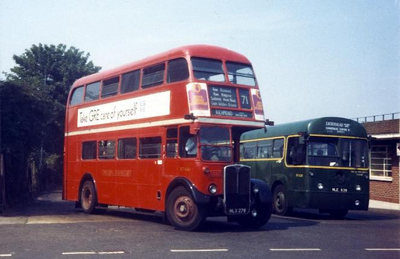
August 1973, and Kingston's
smart RT461 pulls away from Leatherhead Garage forecourt, past
RF639 laying over from the 416, on its long run to
Richmond Lower Mortlake Road.
Photo courtesy London Bus
Scene
Provided priority was given to crew drivers,
OMO drivers were allowed to work rest-days on the 71s. I also
worked a number of rest-days as a ‘shunter’ at Ham, turning RMs
round, when the Petersham Road was closed for several months due to
subsidence.
At this time there was no staff bus operated
out of Kingston, our drivers having to rely on a staff bus provided
by Norbiton, I believe on an overtime basis.
Upon the RFs being withdrawn we worked the
above OMO routes with BLs, a vehicle almost universally hated by
the drivers. I was one of the few exceptions and loved its
manoeuvrability and speedy gear-change, although its light weight
and harsh brakes could be lethal in the wet.
In about 1984, I and all the OMO drivers were
transferred to Norbiton, and all Norbiton’s crews were transferred
to Kingston. As a Norbiton driver I then worked on Metros
(which I liked) and Leyland National LSs (which I hated).
In 1987/8 privatisation began to rear its ugly
head and savage wage cuts and longer hours were introduced. This
caused a protracted industrial dispute, as well a very expensive
High Court case with three drivers (of which I was one), backed by
the TGWU, suing London Transport. (As an aside, our barrister
was one John Hendy, brother of . . . well those familiar with the
transport industry will associate the name). We lost the main
thrust of our case. However, an upshot of the various actions was
that LT gave those drivers who wished a transfer to a garage of
their choice, at existing wages and conditions.
This found me at Fulwell, an exclusively OMO
(or OPO, as women had by now been driving London buses for a few
years) all Metro garage.
The staff bus at Fulwell was operated on what
may have been a unique basis. On the (single) staff rota there was
a rather unpopular duty outlined in red ink. Reliable drivers
could expect to be automatically DXed onto the staff bus instead of
working this unpopular duty. Unreliable drivers, or those who
didn’t want to work through the night, would have to work the
unpopular duty, and a volunteer from a panel would then be
allocated to the staff bus instead.
At night the Fulwell staff bus driver would
start at 23.50 hrs and work as required (i.e. wherever he was asked
to go by a driver signing off), but in the mornings he worked to a
set route. Before 1988 the two staff buses had rendezvoused outside
Kingston so that homebound drivers could switch from one to the
other, but privatisation saw the end of the Norbiton staff bus.
Upon my transfer to Fulwell, I became union
schedules rep at the garage and, as there were now a number of ex
Kingston/Norbiton drivers at the garage, I suggested and worked out
a route which took in much of the old Norbiton staff bus route,
ensuring it came quite close to where I lived in Chessington (well
I wasn’t daft), as well as serving all the original Fulwell
route.
Then, in the early 1990s, privatisation came
along again and, rather than face the same industrial
strife that had taken place at Norbiton (where not even redundancy
was offered), LT offered severance to those members of staff who
wished to take it, rather than sign up for the swingeing pay
cuts.
That then ended my career on the buses after nearly 22 years,
although not my associations with public transport, as in March
1999 I joined Croydon Tramlink (some fourteen months before it
opened to the public) and became one of a handful of its first tram
drivers. I have since retired.'
I am indebted to Ian for his stories. There are more - see
route 218.
Re-creation
The 216 was RF operated at our Kingston RF Event 2009.
|
|